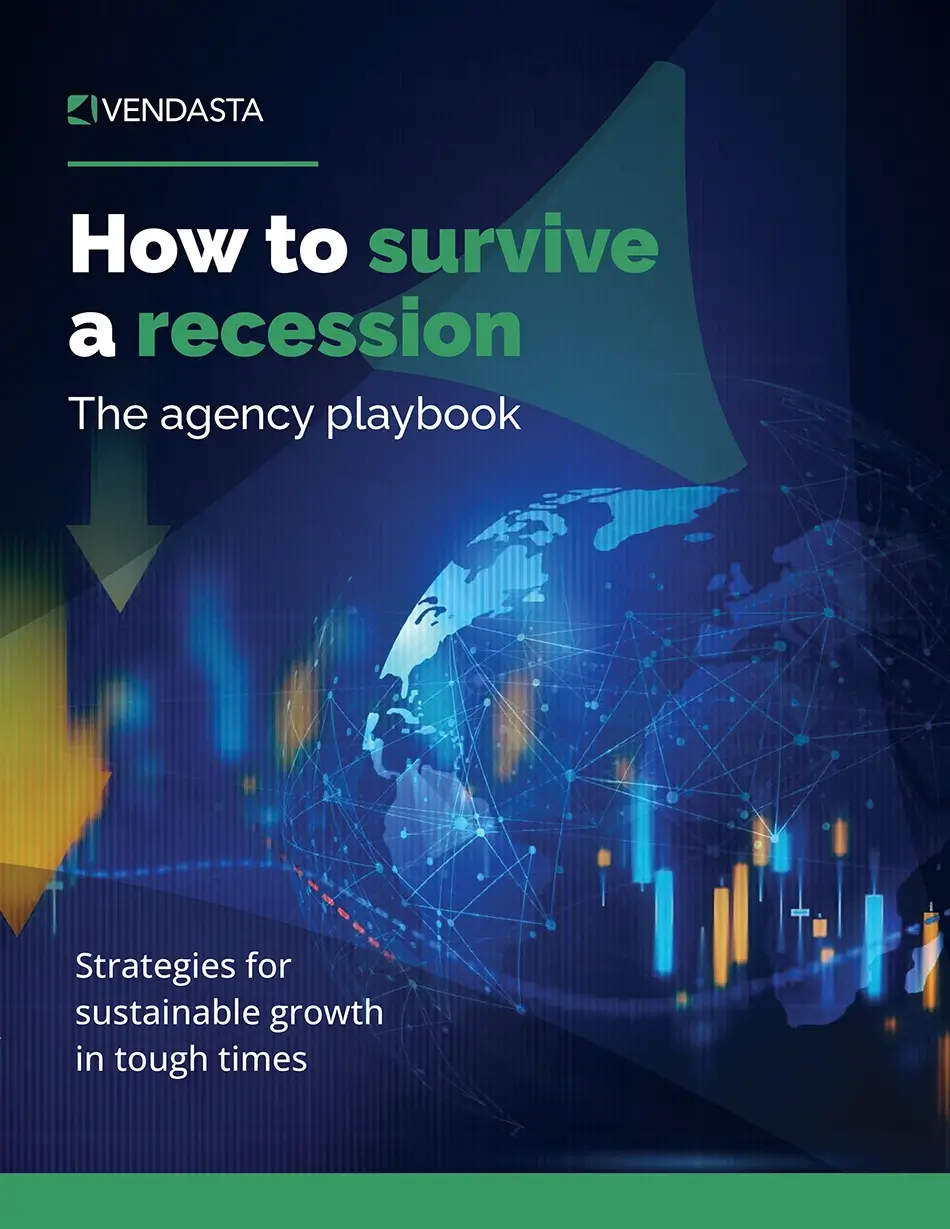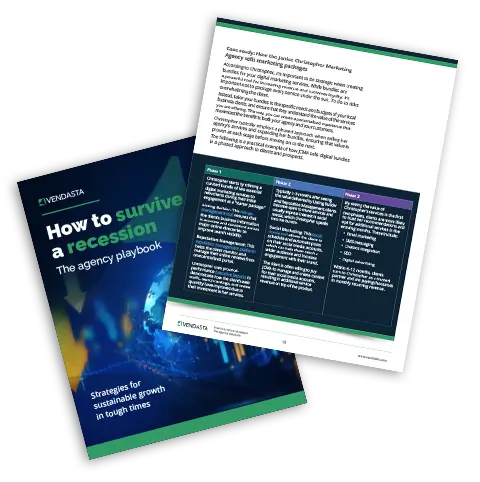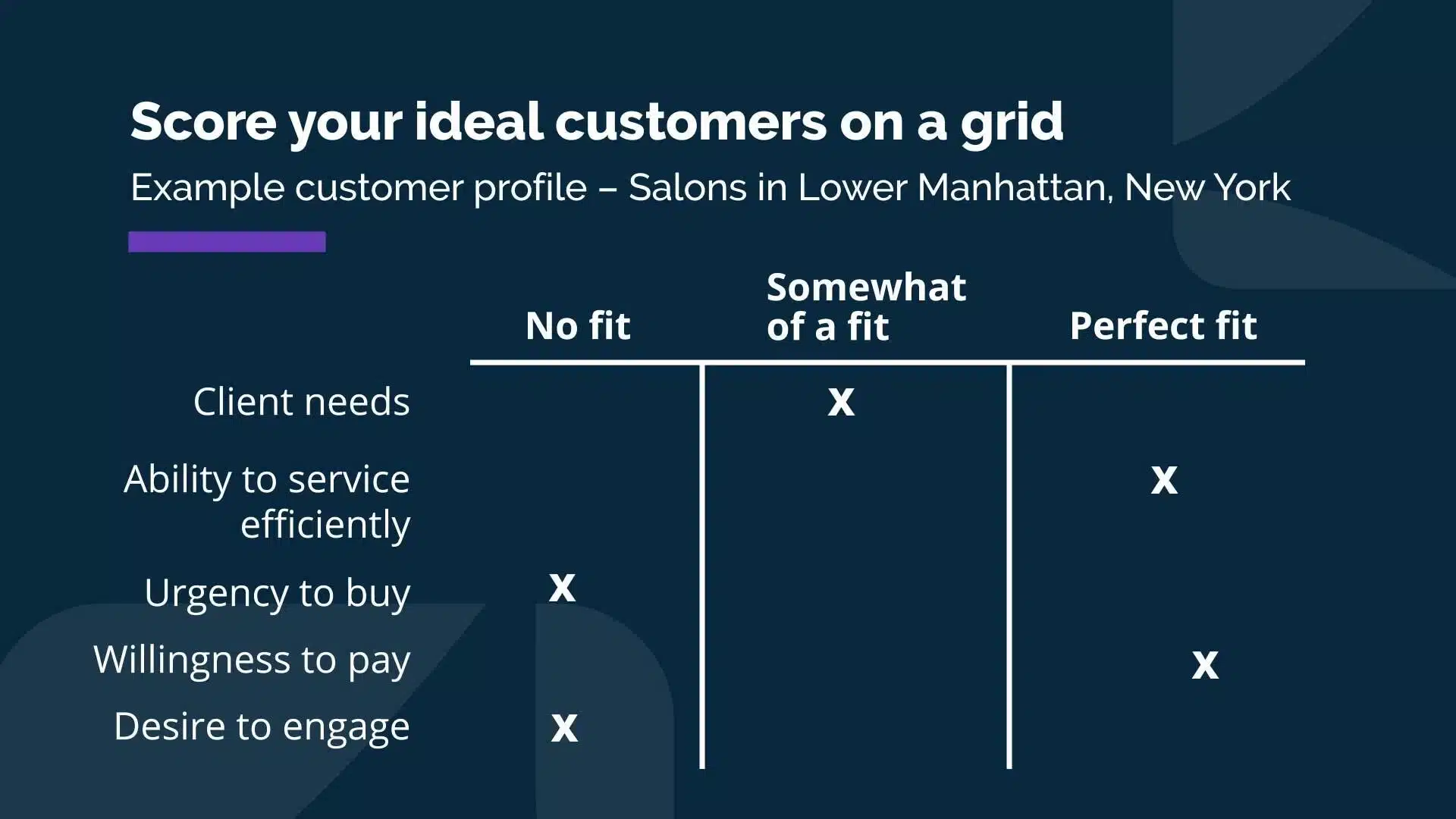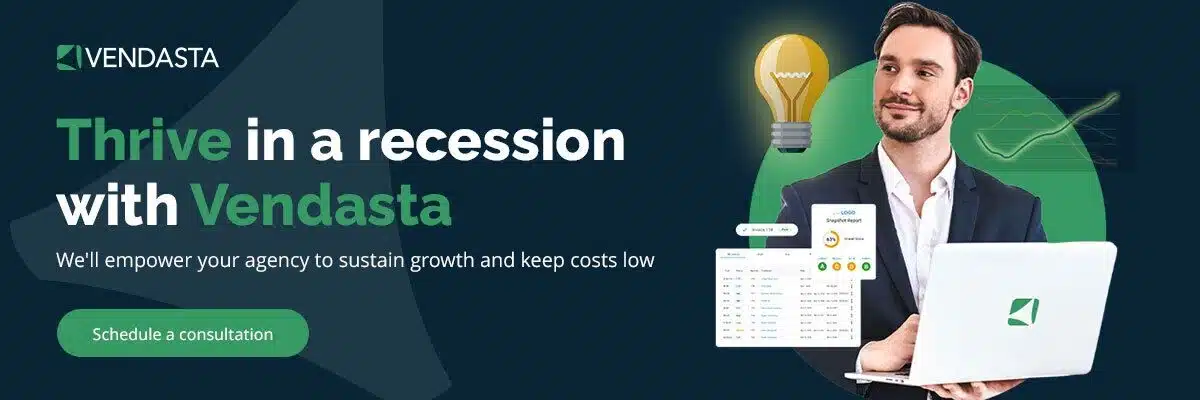Continue reading below to gain the actionable strategies, tactics, and referral program checklist your agency needs to adapt to tougher economic times.

Keep reading to gain:
- Strategies for scaling your agency during a recession
- Access to an ideal customer scorecard to evaluate existing and prospective business
- Tactics for building strong client relationships and providing value-added services
- Tips for diversifying clients and focusing on high-impact opportunities
- Access to a downloadable referral program checklist to tap into warm leads
- Best practices for improving operational efficiency and resource allocation

![]() INTRODUCTION
INTRODUCTION
Executive note
“The world is changing very fast. Big will not beat small anymore. It will be the fast beating the slow.”
Rupert Murdoch
The quote from Rupert Murdoch, CEO of News Corporation and one of the world’s 100 richest people, emphasizes the significance of adaptability and agility in evolving business landscapes. The fast-paced nature of today’s world means that marketing agencies must be able to change and evolve in order to stay competitive.
Economic downturns, recessions, and rising interest rates can make it challenging for agencies to generate revenue as local businesses tend to make fear-based decisions to cut or completely eliminate their marketing budgets. This can make it difficult for marketing services providers to maintain profitability.
Furthermore, the sales process can test the resilience of even the most seasoned business development representatives. Buyers become more cautious and tend to haggle, and an increasing number of decision-makers are involved in approving even the most basic of marketing packages.
To navigate these challenges, your marketing agency must learn to adapt. This entails strategies including targeting new markets, managing costs effectively, automating processes and becoming more innovative in how you sell. This approach will help ensure that your agency stays afloat while competitors that fail to evolve with the market fall by the wayside.
What strategies can a company use in an economic downturn? This guide aims to provide actionable strategies and tactics to help agencies adapt to tougher times. By implementing these strategies, agencies can discover not only how to survive a recession but also how to thrive.
In the following pages, you’ll gain insights from agencies and marketers who adapted to changing economic conditions throughout their careers. You’ll learn:
- Strategies for scaling during a recession
- Tactics for building strong client relationships and providing value-added services
- Tips for diversifying clients and focusing on high-impact opportunities
- Best practices for improving operational efficiency and resource allocation
- Ways to adopt new technology and automate processes to improve productivity.
![]() PART ONE
PART ONE
Reevaluate your client book
Worried about how to survive a recession? Struggling in a tough economy? You’re not alone.
Let’s discuss the state of the economy: It’s experiencing a slowdown, and doing business is simply getting tougher. You’re right about that. This is deliberate—all agencies are feeling the pain because policymakers are raising rates to cool down the economy and stop inflation from spiraling out of control.
Understanding recessions
You’ve heard a lot of chatter in the media about a recession, but what exactly is it and why is it impacting your line of work?
A recession is a period of economic decline, often marked by negative growth in gross domestic product (GDP) for two consecutive quarters. This decline can be caused by a decrease in consumer spending, business investment, and trade.
Recently, in the wake of the COVID-19 pandemic, the Federal Reserve and other central banks have raised interest rates in an effort to slow down the economy and the stock market, and curb inflation caused by lockdowns, supply chain disruptions, and labor shortages.
However, this has led to an increase in the cost of servicing loans, leaving both consumers and businesses with less money to spend, resulting in tighter marketing budgets and job losses. This creates a cycle that further perpetuates the economic downturn until the economy stabilizes and interest rates are lowered again.
The impacts of a downturn are generally uneven, creating winners and losers. Janice Christopher, CEO of The Janice Christopher Marketing Agency (JCMA), notes a difference in how larger and smaller clients are approaching marketing in a tougher economy.
While larger businesses are more cautious, they are still spending and not reducing budgets. Many smaller businesses, however, are cutting costs and reducing services.
“Those who never embraced the idea that the more money they invest, the more they’re going to get out of marketing—those people are reducing their budgets. So if they previously contracted us to do two social media posts per week, they now want one,” Christopher says.
“That’s really made us rethink who we service, how we deliver, and what we can do to become more efficient,” she continues.
Losses, though painful, provide an opportunity for agency owners to reevaluate their customer base and implement adaptive strategies to do more of what has been lucrative. Losses offer an opportunity to clean out the clients who have been difficult to service.
If you want to learn how to thrive in a recession, take it from Jack Pires, CEO of Social Jack Media. The agency’s headcount and revenue nearly doubled to 12 employees and $2 million during 2022, amid all the fearmongering of a recession.
“The phones haven’t stopped ringing and the referrals haven’t stopped coming in from our target markets. Even though we had a few mishaps, we rethought our strategy, resource planning, how we serve different tiers of clients, and how we prove value to each of them, and it’s been an incredibly strong year with more growth to come,” he says.
What strategies can a company use in an economic downturn? 3 actions to take today
1) Double-down on your best clients
In order to maximize revenue, it’s important to focus more on upselling and cross-selling to your existing, high-margin clients.
Take a close look at your customer base and identify opportunities to double-down on the categories of clients that are most valuable to your agency. By reprioritizing your list, you can ensure that your resources are being allocated to the areas that will have the greatest impact on your bottom line.
Try to ensure you’re keeping an open channel of communication and regular check-ins with your clients. It’s the quality of your service that can often break the approval or continuance of a contract, especially in a downturn.


I religiously meet with my better clients every month. They pay me for an hour’s time. And during that time, I show them everything that we’re doing for them and the results.”
Janice Christopher
CEO, The Janice Christopher Marketing Agency
❓ Reflect and identify ❓
- Analyze your clientele: Who are your most profitable and enjoyable clients to work with?
- Understand why they are valuable: What makes these clients stand out and how can you replicate their characteristics in future clients?
- Use positive feedback: Have you ever asked for referrals or testimonials from these top clients? Leveraging their positive experiences can attract new business.
- Assess your service level: Are you providing the best possible service to these valuable clients?
- Identify upselling opportunities: How can you expand your offerings and help these top clients grow their businesses even further?
Take note of these questions in a dedicated notebook or document and spend some time reflecting on them. We will delve deeper into these ideas and strategies later.
WATCH: Setting yourself up for success as a marketing agency
Learn more about Christopher’s methods for determining who your ideal customers from her recent virtual workshop.
2) Reduce services or time spent with certain clients
It’s important to evaluate the level of service provided to each client and ensure it aligns with their needs. By doing so, it allows for better management of resources and can lead to new opportunities. Christopher realized this recently and decided to reevaluate how much time she spends with certain clients who don’t need frequent hand-holding.
“I tell these clients, ‘Hey, you don’t need to meet with me once a month and pay me my fee. We’ve set everything up. Your listings are great. Your reputation’s great. Your website is working. You’re not spending money on anything that we need to discuss every month. So why don’t you save yourself the money or put it toward that website chatbot you always wanted?’,” she explains.
“But really, I’m saving myself those hours every month to go out and look for a new business or service my existing, high-margin clients. They’re happy, and I don’t have to convince them to make more of an investment when for months and years, they’ve been reluctant to increase their investment in marketing.”
Jack Pires agrees. He has divided Social Jack Media’s clients in three tiers: top-tier, mid-tier, and basic.
“The large and mid-tier clients will have 5–6 hours of our time per month, such as with an account manager and content strategist, embedded in our proposal, while the basic ones will have less. All that being said, you need to invest and prove the value to each client no matter their tier,” he says.
Reflect and identify
As you evaluate the level of service provided to each of your clients, consider the following questions:
- Which clients are currently receiving a higher level of service relative to their needs?
- Are they utilizing the technology and tools that have been sold to them effectively?
- Have they been trained on how to use these tools, or would they be willing to receive additional training, in order to handle basic tasks?
- Could you reduce the time invested in these clients without impacting the relationship or service level, for example, through marketing automations and campaigns?
3) Stop working with clients who are underpaying
Assessing your customer base and identifying profitable, easy-to-work-with clients that align with your agency’s value proposition is crucial in tough economic times. It’s one of the keys to how to survive a recession.
On the other hand, terminating contracts with clients who are costing you too much time for little benefit is even more important. And it’s one of the biggest lessons Chris Montgomery, Founder of Social Ordeals, has learned in over 10 years of running an agency.


You have to analyze your book of business and make sure that you actually have a profit margin with your clients because with some clients, you don’t. Sometimes, you have to make that hard decision. Sometimes, clients want to fire you because they want to try out something else. You as an agency owner can’t be scared to fire a client either.”
Chris Montgomery
CEO & FOUNDER, SOCIAL ORDEALS
Reflect and identify
- What does your agency consider to be an acceptable profit margin and level of service?
- Have you spoken to clients about any mismatches between what they are paying and what they are getting? Are they willing to compromise?
- Have you ever had to make the hard decision of letting go of clients that are not a good fit for your company? How did you—or how can you—handle it?
- How do you avoid burning bridges when terminating contracts with clients? How will you approach these difficult conversations? Can you provide solutions, such as referring them to an agency that’s a better fit?
- Are you comfortable with taking a short-term hit to revenue to pursue higher-quality leads and clients?
Rethinking your ideal customer profile—A CMO’s perspective
Agency owners may be questioning the need to alter their Ideal Customer Profile (ICP) after years of following the same approach. The answer is simple: You need to. It’s part of how to survive a recession and make serious money.
How do successful businesses adapt
Did you know? The best businesses are always pivoting when something isn’t working or they see a huge opportunity.
Take inspiration from their successes and consider reassessing your own ICP to stay ahead in today’s market. These companies successfully pivoted their strategies, including updating their ICP:
- American Express: The company adjusted its focus and improved its credit card offering, spruced up its airport lounges, and raised its fees during a pandemic to effectively double down on rich customers. The result? A record number of Platinum cardholders in 2022.
- Instagram: Originally known as BURBN and offering multiple features, the app stripped down to only one core feature: Photos. It got photo-lovers hooked, and this change led to its current 2 billion-plus user base.
- Starbucks: From selling espresso makers and coffee beans, the company transformed into a European-style coffeehouse and became a nationwide coffee sensation after its CEO’s visit to Italy in 1983 inspired him to move beyond selling machines and target caffeine aficionados.
With over 20 years of experience in the industry, Jeff Tomlin, CMO at Vendasta, has seen the importance of constantly rethinking your ICP. This mindset sets apart successful businesses from those that struggle.


As an agency owner, the number-one thing at all times that you should have a really clear view on is what your ideal customer profile looks like. As times change, you have to reevaluate that ICP to see how they are changing and how that affects their needs.”
Jeff Tomlin
CMO, VENDASTA
To stay ahead, it’s essential to understand how your ideal customer profile is evolving as the market changes. Here are some key considerations for agencies looking to optimize their customer relationships:
- Can you still serve customers efficiently? Understanding your cost to serve a customer is crucial in evaluating the efficiency of your operations. This includes the cost of maintaining software, support staff, account executives, and gross margin.
- Do they still have the same urgency to buy? The sales cycle is the best indicator of a customer’s urgency to buy. If the sales cycle is lengthening, it’s a sign that the customer’s urgency is decreasing, possibly due to budget constraints.
- Do they still have the same willingness to pay? To gauge a customer’s willingness to pay, look at the average deal size booked by your sales team. If the average deal size is decreasing, it could indicate a decrease in customer willingness to pay.
- Do they still have the same willingness to engage? Examining win/loss rates, as reported by your sales team, can give you an understanding of your customer’s level of engagement and how it has changed over time.
The Jeff Tomlin scorecard
“Visualizing your ideal customer profile can help you assess their fit with your agency as the market changes,” says Tomlin.
“Create a grid that showcases four categories: efficiency in serving customers, urgency to buy, willingness to pay, and level of engagement. This will give you a clearer understanding of your customers and help you make informed decisions about customer retention.”

Tomlin suggests considering the following three risk metrics when reassessing your ICP and evaluating the fit of your customers with your agency operations:
- The rule of 40: Your growth rate and profit margin should total 40% or more.
- Cost of Acquisition (CAC) payback period: The ideal payback period for enterprise customers is 18–24 months, and for smaller companies, it’s 6–12 months.
- Sales efficiency: Aim to generate $1 of revenue for every $1 spent on sales.
WATCH: A CMO’s perspective: Tactics to navigate a recession
Reimagining the customer experience
The key elements of who you serve and the services you provide must run alongside your ability to deliver an incredible customer experience. This is one of the most important ways you can demonstrate the value of digital marketing while concurrently reducing churn risk and creating a competitive advantage.
A great customer experience can be cut in many different ways; however, in a downturn, there are two key areas for agencies to focus on.
1) Proving the value of your services
“I don’t understand what you’re doing for me” or “marketing is just an expense” are phrases no agency owner wants to hear during a conversation with their clients. Unfortunately, they are common criticisms as many agencies struggle to prove the value of their services.
Customers need to understand the importance of different tactics you’re recommending. By setting appropriate expectations for results, proving marketing return on investment (ROI) goes a long way towards strengthening your relationship with them. Proof of performance, when done right, builds trust in your ability to help clients reach their goals.


It’s important agencies explain that digital marketing is not just about advertising. If you have bad reviews, customers will find you through your digital ads and by having that bad rating score you’re essentially paying them to go check out your competition. It’s always this lightbulb moment like, ‘Oh, now I get why listings matter, why reviews matter, I get why SEO matters, and I understand how digital advertising can complement all of that.’”
Josh Baker
Founder, Sica Marketing
Regular communication, continuous education, and proactive proof-of-performance reporting of your services such as growth in web traffic, number of reviews and followers, and performance against competitors is an essential part of the customer proposition for agencies.
Delight your customers with the right data, at the right time
Check out Proof of performance: Proving marketing ROI to your local business clients to learn more about effective ways to demonstrate the value of your work with local business clients.
2) Providing performance visibility and access
Local businesses often struggle with marketing due to a lack of understanding or complexities in areas such as search engine optimization (SEO) and digital advertising.
Managing and toggling between different accounts including Google Business Profile, Facebook, and Tripadvisor can be time consuming and overwhelming for a busy business owner, especially when it comes to responding to a barrage of reviews and social media posts.
To mitigate these challenges, it’s crucial that agencies provide their clients with control and visibility of their marketing initiatives. This can be achieved through tools and technology that offer a streamlined and user-friendly customer experience, where clients can view their marketing progress and the impact it is having on their business.
“You don’t want to create the perception that you’re working in the shadows. That’s why Vendasta’s Business App is such a central pillar of our customer proposition. The client can log in any time and see their latest reviews and social posts, choose to respond, see their marketing and advertising performance, and access many other services,” Janice Christopher says.
“It also helps reduce the number of times the client asks: ‘What am I getting out of this relationship?’”
Gems of wisdom
Set and manage expectations
Especially in a tougher economy, Christopher strongly recommends agencies set realistic expectations as part of a great customer experience, especially in initial conversations with prospects. You don’t want to over-promise and under-deliver.
“I think setting expectations is ever more important because people are more sensitive when the economy feels hard. [Marketing] can’t be seen as an expense. It has to be seen as an investment that has a return relatively soon.” So I’ll be very clear with a client that in order to get the phone to ring, they need to do some advertising and some SEO. That may feel scary for some prospects, and it’s our job to really educate SMB’s that being there on page one of Google vastly improves their chances of doing more business right away” she says.
![]() PART TWO
PART TWO
Expand and diversify
In today’s economy, businesses are facing challenges like never before. The COVID-19 pandemic has caused widespread disruption, and many companies are struggling to survive. However, there are still opportunities for growth, even in a recession.
What strategies can a company use in an economic downturn? In this section, we will explore several strategies that businesses can use to grow during tough times.
Strategy 1: Scale efficiently with marketing bundles
Every agency owner’s aspiration is to sell as much as possible in one transaction, and that’s exactly what a marketing bundle is designed to do.
Many service providers tend to sell one or two solutions, such as building websites or social media management. Often, this results in local business owners who are frustrated that they need to seek different vendors for different facets of their marketing.
Why not remove that pain point for your clients and prospects by selling a bundle of services together? This strategy is similar to how fast food restaurants offer meal deals—a higher order value in exchange for a slight discount and a better customer experience.
The table below explains more about how a bundling strategy benefits agencies and their clients.
| For marketing agencies | For local businesses |
|---|---|
| Speeds up your sales process: By offering bundled digital marketing packages, your sales team can streamline the process of selling individual services separately. This can help to close deals more efficiently. | Enhances customer experience: Purchasing a bundle is easier and more convenient for local businesses than buying, for example, social media tools, search engine optimization services (SEO), and web design from three separate providers. |
| Maximizes revenue potential: By packaging various services together, agencies can increase the value of each deal. These bundled deals come with a discounted price, making them more appealing to clients and more likely to convert than a single service at full price. | Better business outcomes: Marketing is a holistic strategy. When a local business has their reputation management, social marketing, and SEO working in tandem, they are likely to see better results and tangible business growth as a result. |
| Stand out from the competition: Many agencies offer a limited number of services. By packaging and selling a wider array of marketing solutions, your clients will look to you as the trusted local expert who can help solve all their problems. | Clients discover valuable products and services: Offering bundled deals that include a mix of popular and lesser-known items can encourage customers to try new products they may not have otherwise considered because of the discount baked into the price. |
| Improves retention and loyalty: By providing a one-stop shop for all of their needs, your clients are more likely to return to your agency for additional services. This is because they have already invested in your solutions and trust your ability to meet their needs. | Lowers costs: What local business owner doesn’t love a discount? When purchasing a discounted bundle, clients feel good knowing that they are saving money and getting better value. |
Case study: How the Janice Christopher Marketing Agency sells marketing packages
According to Christopher, it’s important to be strategic when creating bundles for your digital marketing services. While bundles are a powerful tool for increasing revenue and customer loyalty, it’s important not to package every service under the sun. To do so risks overwhelming the client.
Instead, tailor your bundles to the specific needs and budgets of your local business clients, and ensure that they understand the value of the services you are offering. This way, you can create a personalized experience that maximizes the benefit to both your agency and your customers.
Christopher typically employs a phased approach when selling her agency’s services and expanding her bundles, ensuring that value is proven at each stage before moving on to the next.
The following is a practical example of how JCMA sells digital bundles in a phased approach to clients and prospects.
| Phase 1 | Phase 2 | Phase 3 |
|---|---|---|
|
Christopher starts by offering a curated bundle of two essential digital marketing services to new clients as a “starter package.” Listing Builder: This listings management tool ensures that the client’s business info is consistent across directories to boost visibility. Reputation Management: This platform helps clients monitor and manage reviews from one dashboard. Christopher uses proof-of-performance Executive Reports to showcase results. |
Typically 2–3 months later, clients recognize the value of Phase 1 and express interest in social media, which Christopher upsells. Social Marketing: This social media tool allows clients to schedule and automate posts, increasing brand engagement. Clients often pay JCMA to manage and create content, adding service revenue on top of product value. |
Seeing results from earlier phases, clients begin to trust Christopher’s guidance and invest in additional services:
Within 6–12 months, Christopher becomes a trusted advisor with clients spending thousands in monthly recurring revenue. |
“By bundling these services together, clients receive a comprehensive solution that addresses multiple aspects of their online presence and marketing efforts. Additionally, it’s convenient for them because they only need to work with one agency for all their digital marketing needs,” explains Christopher.
Reflect and learn
- Does your agency currently sell digital solutions or limited individual services? Would it lead to a better client outcome if you could do more for them?
- Are your starter bundles easy to understand for clients and prospects? Do you need to cut the number of services sold initially to improve conversion? Alternatively, can you add a service that would improve conversion?
- Can you demonstrate proof of performance quickly? Can clients see and access what they’ve purchased?
- Does your agency have a strategy around how to build on the initial package, and when?
Strategy 2: Maximizing revenue from existing clients
Partly related to the prior strategy, another strategy for how to survive a recession is to upsell your existing clients with highly targeted services and offers based on specific needs. This includes new products or additional investments into existing services.
Tip: Do your research!
Whatever you do, don’t sell for the sake of selling! Your existing clients can smell it from a mile away and will start to feel like every meeting with you is a sales pitch.
Christopher strongly recommends agencies using this strategy have a very deep understanding of their clients’ needs, business goals, and current market positioning. In other words, you need to sound like you’ve done your research and are solving a pain point or targeting a great new opportunity for the client.
“Before my meetings, I always review the client’s marketing performance, business plan, and whether there’s an opportunity for us to write a blog for them, leverage their database for email campaigns, or increase their budget towards ad campaigns if they’ve been effective,” she says.
“We’ve found that clients really like the ‘try before you buy’ approach that we take. For example, let’s see if we can generate some interest with that newsletter, or improve their Google rankings with that blog. Once they see that our ideas work, they’re happy to increase the monthly budget on a more permanent basis.”
Strategy 3: Diversify your client roster
So we’ve talked about marketing bundles and existing clients, but what about drumming up new business? That’s the hardest part.
While it’s true that a downturn has a broad impact on business spending, what’s also true is that there are pockets of opportunities in recession-proof industries.
What does recession-proof mean? “Recession-proof” or “defensive” industries are sectors where spending and profitability tend to remain stable or even grow in tough times.
Think of areas such as healthcare, home services, and pet food—we all still need to see the doctor, prevent leaky plumbing, and feed our furry friends no matter what the economy is doing.
Tips for targeting new verticals
As a marketing agency, expanding your client base to include recession-proof industries can be a valuable strategy during economic downturns. Here are some tips on how to sell your marketing services to these industries:
- Research: Get to know your target industry and its unique challenges, needs, and goals.
- Network and use social media: Connect with industry professionals, attend events, and engage in online forums to gain insights and build relationships. Leverage social media and job posting websites to discover whether local businesses need help with their marketing efforts—this can be invaluable for your prospecting playbook.
- Show case studies: Highlight your agency’s experience in related industries via case studies and how you’ve driven growth for existing clients.
- Customize your pitch: Tailor your marketing proposal to address the specific needs and goals of your target industry.
- Leverage data: Use data and statistics to demonstrate the potential impact of your marketing services and how they can support the industry during economic challenges.
View downturns as a wake-up call and an opportunity to pivot
A downturn can be a wake-up call and give you the opportunity to reset who you serve and how your agency is positioned in the market.
“What we’re seeing in terms of economic conditions now has made me reprioritize my book and rethink who I want to work with in the long term,” explains Christopher.
“It made me realize there are some clients who I really enjoy working with. They are high-revenue, they’re open to new concepts, and their marketing budgets are resilient. That’s what I want more of.
“On the other hand, there are low-margin clients who look at marketing as an expense, and every time they run into some business difficulty, they cut their marketing budget, which means the stability of earnings isn’t there. Having to renegotiate a budget on a regular basis just isn’t what we’re set up to do.”
Below are three industries Christopher is prioritizing targeting, and two she is stepping back from right now.
Top pick: Legacy businesses
Christopher loves legacy businesses, which are long-term and financially stable companies that are at a critical inflection point in their strategy.
“You have multiple generations in these legacy businesses where the 75-year-old owner claims, ‘We don’t need to do marketing,’ whereas the sons and daughters—the heirs—absolutely believe they need marketing for future growth,” she says.
“And so they can’t convince dad, but I can come in as the expert and bring everyone together. And those are companies that have been around 50, 60, 75 years, and they’re doing multiple millions of dollars of business.
“I show them how having a strong online presence protects the value of their brand and keeps their business relevant and competitive in the local marketplace.”
Top pick: Mental health services
Christopher has also found success in the mental health services industry, which has seen an increase in demand during the pandemic and in light of broader recognition of mental health issues.
“There are not enough psychologists or social workers in the United States to fill the need for mental health services,” she says.
“They need to do a lot of marketing, and they need their messaging to be on point because people have a choice where they’re going to go, and my clients want to make sure that they’re chosen.”
Top pick: Essential home services
Businesses that specialize in home improvement and repair, such as plumbing, electrical, painting, and gutter cleaning tend to do well during a recession.
As Christopher says, “It doesn’t matter what’s happening with the economy, you still need the heat to work and the taps to not leak. Companies involved in the repairs and maintenance of residential and commercial properties are very resilient for that reason.”
Top pick: Construction and related services
Pires says construction and related services (such as logistics and materials suppliers) have proven surprisingly resilient, and marketing is becoming more important to these comes from both B2B and B2C perspectives.
This is likely due to immigration driving almost all U.S. population growth, while COVID-19 has changed what people are seeking when it comes to housing.
Avoid: Solopreneurs
Christopher avoids working with solopreneurs, who are typically unable to afford her services on a regular basis, and thus make it difficult for her to scale and earn predictable revenue.
Avoid: Restaurants
She also avoids working with restaurants, as she has found that their margins are too small to justify her services and typically require too much work from a sales perspective to convert.
Ideas: Looking for more recession-proof industries
Check out 11 recession-proof industries agencies should sell to right now for more ideas of industries you can target right now!
Strategy 4: Elevate your onboarding, prospecting, and customer experience
Montgomery’s success story of growing Social Ordeals from a one-man agency to a 30-strong team generating $8 million in annual revenue by serving thousands of SMBs across the US, UK, and Canada is a testament to his effective business strategies.
He attributes much of his success to four key factors, which will become even more important for agencies seeking how to survive a recession and grow during an economic downturn.
- Personalized communication: Montgomery emphasizes the importance of personal engagement, even for mid-market agencies with a sales team. He suggests getting on client calls yourself or attending them with your reps, to build a strong relationship and show your commitment to their business. Even today, Montgomery finds new business during in-person experiences such as meeting the owner after dining at a restaurant.
- Impeccable service: Providing top-notch service to your first few clients can lay the foundation for a successful business. Montgomery says, “You have to make sure that you’re doing everything that you promised them that you would do, and you’re keeping your word on that.” Building trust and delivering results can earn you referrals and repeat business.
- Quick response time: Prompt responses to inbound inquiries is key to keeping clients and prospects interested. Montgomery says, “People are impatient today. If a prospect calls you, and you don’t get back to them for 48 or 72 hours, you’re putting a bad taste in their mouth.”
- Thorough onboarding process: Montgomery’s agency has a detailed onboarding process that involves clients filling out a form and a video conference call with account managers. This helps ensure that clients are well-informed and have a clear understanding of the agency’s services, and that the knowledge is not limited to one person.
Strategy 5: Using fulfillment services to deliver work that you otherwise couldn’t offer clients
A final strategy for how to survive a recession, grow your client base, and grow your revenue is using fulfillment services to deliver work that you otherwise couldn’t offer clients due to skills and resource constraints within your agency.
By partnering with high-quality external fulfillment partners, you can free up your time and resources to focus on growing your business. Additionally, using fulfillment services can also help to reduce costs, as they often have economies of scale that allow them to offer services at a lower cost than you could on your own.
Fulfillment services are also known as “white-label” marketing and can be used for nearly all facets of digital marketing including copywriting, writing social posts, building websites, and listings management.
Typically, agency owners resell fulfillment services to supplement knowledge and skills gaps in their organizations and to de-risk their business. The agency’s in-house team focuses on sales and high-value services such as setting the client’s marketing strategy and providing proof of performance. Meanwhile, fulfillment experts work in the background to do the execution.
| Where your agency can invest its time and focus | How white-label marketing can complement your services |
|---|---|
| Selling listings and reputation management | Fulfillment services can handle the technical aspects of setting up, claiming, and managing clients’ online presence and review responses. |
| Selling social media services and setting the strategy (frequency of posts, tone of voice, etc.) | Fulfillment services can handle the day-to-day content creation, posting, and management of social media accounts for clients. |
| Selling websites and consulting on design | Fulfillment services can handle the technical aspects of website creation, freeing up time and resources for the agency to focus on consulting with clients on design and user experience. |
| What are the benefits of this approach? | Tasks fulfilled by white-label marketing |
|---|---|
|
This approach allows the agency to focus on their strengths, build client relationships, and expand their services while the client’s online presence is professionally managed.
Furthermore, the agency doesn’t need to hire and train staff. |
Listings setup, management, optimization
Claiming listings for the client Respond to reviews on behalf of the client |
|
This approach enables the agency to concentrate on developing high-level strategy and building relationships with clients.
Meanwhile, time-consuming social media tasks are handled by an expert fulfillment team. |
Social media content creation
Responding to comments on social channels Scheduling posts |
| This approach allows the agency to provide a more comprehensive service to clients by offloading the technical aspects of website creation, while still retaining control over the creative process. | Website build and design |
Strategy 6: Leverage the power of referrals, networking, and community
In Part 1, we asked you to reflect and identify opportunities to grow your book of business by leveraging your current clients while also seeking out new prospects. How does a successful agency make that happen?
Jack Pires of Social Jack Media, who achieved a 100% increase in revenue last year and had to double his workforce to meet the demand, attributes much of his growth to three factors:
Referrals from current clients: Encouraging your existing clients to refer new business to you is a powerful way to grow your book of business. “Fortunately, many of my clients provide referrals because of our strength, expertise, and credibility in certain verticals,” he says. To increase the number of referrals, agencies can consider creating an incentive program for those who provide them.
In-person networking: Networking events and trade shows can provide valuable face-to-face interaction with potential clients. “There are a ton of networking groups available at very low fees, such as your local Chamber of Commerce. If you can invest some time in the ones that make sense for your sales team or you personally, it can do wonders. When you’re face to face with someone, you can build trust and make a personal connection,” says Pires. This approach can also help you break into new and recession-proof industries.
Referring clients to each other: Building relationships with other business owners in your industry can lead to mutual referrals. By connecting your clients with complementary businesses, you not only provide valuable resources but also strengthen your own network. Consider forming a referral network or participating in a local business association to expand your reach.
“We always put our clients first, and it’s surprising that they become our liaison and refer other businesses to us. And then what we found is that because we had all these connected businesses within the same vertical, we would refer them to each other from our own network, such as a building company that needs a materials supplier,” Pires says.


If you can make your clients feel as if you’re always looking out for their best interest and if you’re always trying to tap them and network for them, I think that’s a key strategy that most agencies are probably not doing.”
Jack Pires
Founder and CEO, Social Jack Media
Referral program checklist
Referrals are a low-effort, high-value and cost-effective way to generate warm leads. However, a referral program should be well thought out in order to be effective. Here are some key considerations:
- Offer incentives: Some of your existing clients may require added motivation to refer you. Your program should incorporate rewards, discounts, or royalties.
- Define clear terms: Ensure the referral program’s terms and conditions are clear and easy to understand.
- Identify ideal referral sources: Identify which clients and industries are most likely to provide valuable referrals and focus on building relationships with them.
- Develop a tracking system: Create a simple and user-friendly system for submitting and tracking referrals for your agency.
- Refine your communications strategy: How exactly will you and your sales team communicate the program? In client meetings, courtesy calls, or perhaps targeted email campaigns? Whatever methods you choose, ensure the messaging is consistent and gets to the clients you have good relationships with.
- Evaluate and adjust: Regularly evaluate the effectiveness of your referral program and make adjustments as needed to optimize results.
![]() PART THREE
PART THREE
Streamline for efficiency
Here, we’ll explore two ways you can simplify your business while improving efficiency.
1. Simplify your tech stack
Agencies can quickly reduce their expenses by streamlining their technology stack. Surprisingly, businesses with fewer than 50 employees usually have 40 to 50 software-as-a-service (SaaS) subscriptions, but their employees only use about 9.5 of them, according to research from Blissfully.
By examining all costs and eliminating unnecessary subscriptions, digital agencies can lower operational expenses, paving the way for a sustainable cost base and competitive advantage.
As an example, Christopher found hundreds of dollars in monthly savings for JCMA by scrutinizing her technology stack.
She reconfigured her CRM, reducing the cost from $500 a month to under $100 a month, allowing her to invest in other initiatives to improve her workflow. In tough economic times, it’s a good idea to review your tools and the value they bring your employees and your agency, and not just keep them because they have always been used.
Transform into a lean agency: Get your step-by-step action plan and checklist
Is your agency struggling with too many SaaS subscriptions and unable to quantify their value?
Our Vice President of Platform Operations, Janessa Yeomans, has created a free software vendor analysis spreadsheet to help agencies take stock of all their SaaS and subscription expenses.
This tool provides practical steps for examining which subscriptions to retain, eliminate, and renegotiate so that your agency can become leaner and more efficient within just two weeks.
(By the way, Vendasta is the all-in-one tech stack of choice for thousands of agencies and local businesses. Why not take advantage of free access and check us out today?)
2. Sales & marketing automations
Agencies can optimize their operations and improve efficiency by leveraging sales and marketing automations. Time saved is money saved, after all. From prospecting to lead generation, there are several automations that can help streamline your business processes and free up valuable time for your team.
Below are three automations that can save you and your sales team hours of time and effort in your prospecting efforts and marketing processes.
Sales intelligence tools
Sales intelligence tools offer your team the ability to conduct comprehensive research on a prospect’s marketing channels, including their reviews, SEO performance, and digital advertising efforts.
For example, Vendasta’s Snapshot Report generates a Google-powered analysis of a prospect’s online marketing performance across seven categories within 24 hours, enabling salespeople to quickly identify areas of improvement and present the most relevant solutions.
Marketing education campaigns
After closing a deal, it’s essential to keep your client engaged and informed, especially if they’re using digital solutions you’ve sold to them.
Take Scott Sanderson, Founder of OctoHub, as an example. He has created automated campaigns that provide customers with actionable insights and education on various topics, such as the importance of up-to-date listings information and ways to improve their online presence. These emails reduce the amount of time Sanderson’s sales team spends answering basic marketing queries.


We try to give them bite-sized actionable insights to keep them engaged, re-engage them, and earn their trust along the way. And if you look at our approach overall, that’s how we find opportunities, onboard them, and scale. With that process, we’re sitting at over 2,100 customers today.”
Scott Sanderson
Founder, Octohub
Artificial intelligence
Last but not least, we know how big artificial intelligence (AI) is becoming and the immense potential of platforms such as ChatGPT. Artificial intelligence can help post content on social media and provide AI-powered insights and automated responses to reviews and comments.
This allows you to automate routine tasks and focus on higher-level strategic work that requires human expertise. Tools such as Vendasta’s Reputation Management have already integrated AI-powered responses, so you or your client can respond to reviews instantly.
![]() Conclusion
Conclusion
Navigating the recession with Vendasta
In this guide, we aimed to provide you with fresh perspectives and innovative solutions to tackle the current business landscape. We hope you’ve learned some strategies for how to survive a recession as an agency owner.
Here’s a quick summary:
- Reassess your target market and position in the market.
- Explore growth opportunities by offering bundled services, using third-party fulfillment services to meet more of your clients’ needs, and entering recession-proof industries.
- Streamline your operations and reduce costs by simplifying your technology and implementing automations.
To successfully execute these strategies, it’s crucial to partner with the right provider that offers educational resources, cutting-edge technology, and third-party fulfillment services. By transforming into a one-stop shop, you can meet the needs of your clients and impress prospects with your business intelligence tools and services.
About Vendasta
Vendasta is a comprehensive platform designed to support local experts in delivering digital solutions to small and medium-sized businesses. From marketing and selling to billing and fulfilling, Vendasta makes it easy to manage your business.
Unlock your agency’s full potential and thrive in this challenging market. Schedule a demo with Vendasta today to see how we’re helping agencies like yours overcome economic downturns.

